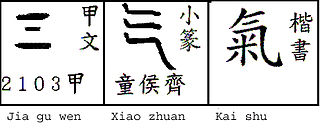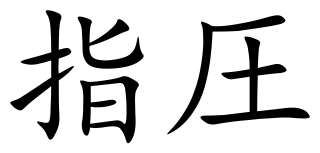Related Research Articles

Acupuncture is a form of alternative medicine and a component of traditional Chinese medicine (TCM) in which thin needles are inserted into the body. Acupuncture is a pseudoscience; the theories and practices of TCM are not based on scientific knowledge, and it has been characterized as quackery. There is a range of acupuncture variants which originated in different philosophies, and techniques vary depending on the country in which it is performed, but can be divided into two main foundational philosophical applications and approaches, the first being the modern standardized form called eight principles TCM and the second an older system that is based on the ancient Daoist wuxing, better known as the five elements or phases in the West. Acupuncture is most often used to attempt pain relief, though acupuncturists say that it can also be used for a wide range of other conditions. Acupuncture is generally used only in combination with other forms of treatment.
Alternative medicine is any practice that aims to achieve the healing effects of medicine despite lacking biological plausibility, testability, repeatability, or evidence from clinical trials. Complementary medicine (CM), complementary and alternative medicine (CAM), integrated medicine or integrative medicine (IM), and holistic medicine are among the various attempts to capture the combination of alternative practices with those of mainstream medicine. Alternative therapies share in common that they reside outside of medical science and instead rely on pseudoscience. Traditional practices become "alternative" when used outside their original settings and without proper scientific explanation and evidence. Frequently used derogatory terms for relevant practices are new age or pseudo- medicine, with little distinction from quackery.

Traditional Chinese medicine (TCM) is an alternative medical practice drawn from traditional medicine in China. It has been described as "fraught with pseudoscience", with the majority of its treatments appearing to have no logical mechanism of action.

In traditional Chinese culture and the East Asian cultural sphere, qi, also ki or ch'i in Wade–Giles romanization, is believed to be a vital force forming part of any living entity. Literally meaning "vapor", "air", or "breath", the word qi is often translated as "vital energy", "vital force", "material energy", or simply as "energy". Qi is the central underlying principle in Chinese traditional medicine and in Chinese martial arts. The practice of cultivating and balancing qi is called qigong.

Acupressure is an alternative medicine technique often used in conjunction with acupuncture or reflexology. It is based on the concept of life energy which flows through "meridians" in the body. In treatment, physical pressure is applied to acupuncture points or ashi trigger points with the aim of clearing blockages in these meridians. Pressure may be applied by hand, by elbow, or with various devices.

Massage is the manipulation of the body's soft tissues. Massage techniques are commonly applied with hands, fingers, elbows, knees, forearms, feet, or a device. The purpose of massage is generally for the treatment of body stress or pain. In European countries, a person professionally trained to give massages is traditionally known as a masseur (male) or masseuse (female). In the United States, these individuals are often referred to as massage therapists, because they must be certified and licensed as "licensed massage therapists".

Shiatsu is a form of Japanese bodywork based on pseudoscientific concepts in traditional Chinese medicine such as qi meridians. Having been popularized in the twentieth century by Tokujiro Namikoshi (1905–2000), shiatsu derives from the older Japanese massage modality called anma.
Rolfing is a form of alternative medicine originally developed by Ida Rolf (1896–1979) as Structural Integration. Rolfing is marketed with unproven claims of various health benefits. It is based on Rolf's ideas about how the human body's "energy field" can benefit when aligned with the Earth's gravitational field.

Auriculotherapy is a form of alternative medicine based on the idea that the ear is a micro system, which reflects the entire body, represented on the auricle, the outer portion of the ear. Conditions affecting the physical, mental or emotional health of the patient are assumed to be treatable by stimulation of the surface of the ear exclusively. Similar mappings are used by several modalities, including the practices of reflexology and iridology. These mappings are not based on or supported by any medical or scientific evidence, and are therefore considered to be pseudoscience.

Reflexology, also known as zone therapy, is an alternative medical practice involving the application of pressure to specific points on the feet, ears, and/or hands. This is done using thumb, finger, and hand massage techniques without the use of oil or lotion. It is based on a pseudoscientific system of zones and reflex areas that purportedly reflect an image of the body on the feet and hands, with the premise that such work on the feet and hands causes a physical change to the supposedly related areas of the body.
In alternative medicine, bodywork is any therapeutic or personal development technique that involves working with the human body in a form involving manipulative therapy, breath work, or energy medicine. Bodywork techniques also aim to assess or improve posture, promote awareness of the "bodymind connection" which is an approach that sees the human body and mind as a single integrated unit, or to manipulate the electromagnetic field alleged to surround the human body and affect health.

Cupping therapy is a form of alternative medicine in which a local suction is created on the skin with the application of heated cups. Its practice mainly occurs in Asia but also in Eastern Europe, the Middle East, and Latin America. Cupping has been characterized as a pseudoscience and its practice as quackery.

Traditional Korean medicine refers to the forms of traditional medicine practiced in Korea.
Manual therapy, or manipulative therapy, is a physical treatment primarily used by physical therapists, physiotherapists, occupational therapists to treat musculoskeletal pain and disability; it mostly includes kneading and manipulation of muscles, joint mobilization and joint manipulation. It is also used by Rolfers, massage therapists, athletic trainers, osteopaths, and physicians.

Edzard Ernst is a retired German academic physician and researcher specializing in the study of complementary and alternative medicine. He was Professor of Complementary Medicine at the University of Exeter, allegedly the world's first such academic position in complementary and alternative medicine.
Blood stasis (BS) is a concept in traditional Chinese medicine (TCM), described as a slowing or pooling of the blood due to a disruption of heart qi. Blood stasis is also described by practitioners of TCM in terms of yin deficiency, qi deficiency and qi stagnation. For non-practitioners of TCM it is sometimes explained in terms of hematological disorders such as hemorrhage, congestion, thrombosis or local ischemia, and in terms of tissue changes. TCM practitioners believe it is an important underlying pathology of many disease processes despite the fact that objective, consistent methods for measuring the presence of blood stasis syndrome are not readily available. Blood stasis is associated with justifications for acupuncture and herbal treatments.
Zero balancing is a type of manual therapy devised by American osteopathic doctor Frederick "Fritz" Smith in the 1970s. Drawing from principles of osteopathy, Chinese medicine and Structural Integration, Smith proposed that the energy field within the human body could be affected by manual manipulations, so bringing health benefits. The practice teaches that currents of energy are stored within the human skeleton, and that these affect both physical and mental wellbeing.
Randolph Stone was an Austrian-American chiropractor, osteopath and naturopath who founded polarity therapy, a technique of alternative medicine. He had an interest in philosophy and religions, and encountered Ayurvedic philosophy on a trip to India. His background in chiropractic was shaped by his studies of various Eastern concepts of energy medicine, including Ayurveda, traditional Chinese medicine, yoga, and reflexology.
Alternative medicine describes any practice which aims to achieve the healing effects of medicine, but which lacks biological plausibility and is untested or untestable. Complementary medicine (CM), complementary and alternative medicine (CAM), integrated medicine or integrative medicine (IM), and holistic medicine are among many rebrandings of the same phenomenon.
References
- ↑ Yu, T'ae-u (1988). Koryo sooji chim. Eum Yang Mek Jin Pub. Co. ; San Mateo, CA : Distributed by the Koryo Hand Acupuncture Institute of America. Retrieved 13 August 2016.
- 1 2 Selin, Helaine (2006-04-11). Medicine Across Cultures: History and Practice of Medicine in Non-Western Cultures. Springer Science & Business Media. p. 152. ISBN 9780306480942 . Retrieved 13 August 2016.
- ↑ Mosby's Dictionary of Medicine, Nursing & Health Professions. Elsevier Health Sciences. 2016-04-28. p. 998. ISBN 9780323414197 . Retrieved 13 August 2016.
- ↑ Lee, Jonathan H. X.; Nadeau, Kathleen M. (2011). Encyclopedia of Asian American Folklore and Folklife . ABC-CLIO. p. 710. ISBN 9780313350665 . Retrieved 13 August 2016.
- ↑ Oleson, Terry (2014). Auriculotherapy Manual: Chinese and Western Systems of Ear Acupuncture. Elsevier Health Sciences. p. 33. ISBN 9780702035722 . Retrieved 13 August 2016.
- ↑ "Hand Reflexology: The Ultimate Guide to Hand Reflexology". MindBodyPal. 2019-01-21. Retrieved 2020-03-30.
- ↑ "Lotus | KHT: Korean Hand Thearpy for Instant Pain Relief". www.elotus.org. Retrieved 2020-03-30.
- ↑ Snyder, Mariah; Lindquist, Ruth (2009-11-10). Complementary & Alternative Therapies in Nursing: Sixth Edition. Springer Publishing Company. ISBN 978-0-8261-2428-9.